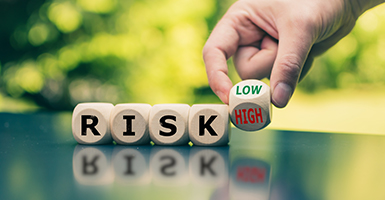 |
Stephen Yiu is the Chief Investment Officer at Blue Whale Capital and Lead Manager of the Blue Whale Growth Fund. Stephen co-founded Blue Whale Capital with Peter Hargreaves, co-founder of Hargreaves Lansdown, in 2016. The Blue Whale Growth Fund was launched in September 2017 and is a long-only global equity fund focusing on developed markets. Stephen adopts a high conviction, active approach based on bottom-up, fundamental research. |
Stephen shared his views in a short article below:
Blue Whale Growth Fund – Three new pitfalls for investors in a post-Covid world – beyond just “high leverage”
Around the world, many companies suffered heavy losses as the full effect of a global lockdown became apparent. Many are speculating that these companies, now at bargain basement prices, should recover to their pre-Covid levels and therefore represent extraordinary value for investors.
While this may be the case for some companies, at Blue Whale we do not think this is as prevalent as others would have you believe. In fact, we see many reasons why a lot of companies should be avoided as they are unlikely to deliver either growth or income for investors.
One commonly expressed view is that, provided an investor steers clear of highly indebted companies they should be alright. While we agree that these companies present risks that are best avoided at this time, we think it should go further than this. Below we outline three types of companies that we think are best left alone for the time being.
1. Low Quality “Bargains”
Obvious examples of low-quality bargains are aplenty among cyclical companies with levered balance sheets and poor pricing power – the likes of miners and energy companies. These companies tend to perform poorly in any downturn, so are not directly tied to the specifics of this global pandemic.
However, a more insidious species of low-quality companies is those that we believe have “Old World” business models. We define these as companies that have failed to adapt to changing customer expectations and whose growth and profitability are structurally challenged – high street retailers and banks are key examples here. Often their branding can trap investors into thinking they are valuable companies, but they end up delivering, at best, stagnant returns over the long term.
In both cases (cyclical companies and structurally challenged “Old World” incumbents), Covid-19 was simply a catalyst to accelerate their inevitable decline.
2. Post-Covid Quality Traps
These are companies which, prior to the outbreak, would have been considered as having high-quality business models, but have since been rocked by the new-normal of social distancing and government mandated lockdown.
Falling under this category, we include coffee chains, hotels and children’s themed holiday parks. These sectors are seeing longer term revenue growth coming into question with social distancing protocols reducing their ability to operate at full capacity. In addition, compliance with more stringent public health standards means that margins become squeezed for the foreseeable future. All of this signifies poor returns for investors – regardless of their perceived brand value.
3. Bubble stocks
With the new-normal setting in, many of us have taken to video conferencing, increased streaming of entertainment and exercising from home. In return, a number of companies which cater specifically to these examples have seen their share prices rocket as they are perceived as beneficiaries of the post-Covid world.
While home exercise machines and streaming services have certainly had their moment in the sun during this pandemic, quite often their business models simply do not hold up to the great expectations heaped upon them, with little to no ability to turn a profit over and above cash needs.
In the three examples above of the types of businesses we are avoiding, we need to be clear on one thing – we’re not forecasting that they disappear into oblivion. We are simply sharing our view that we see little chance of outperformance from these types of businesses, where underperformance is the more likely outcome.
LF Blue Whale Growth Fund is manufactured by Blue Whale Capital LLP and represented in Malta by MeDirect Bank (Malta) plc.
Blue Whale Key Risks & Disclaimers:
The opinions, data, and analyses presented herein is issued for information only by Blue Whale Capital LLP (“Blue Whale”) which is a limited liability partnership incorporated in England and Wales under number OC414255. Blue Whale is authorised and regulated by the Financial Conduct Authority (“FCA”).
The contents presented herein are based upon sources of information believed to be reliable, however, save to the extent required by applicable law or regulations, no guarantee, warranty or representation (express or implied) is given as to its accuracy or completeness and, Blue Whale, its members, officers and employees do not accept any liability or responsibility in respect of the information or any views expressed herein. All data is sourced from Blue Whale unless otherwise stated.
The contents herein may include or may refer to documents that include forward-looking statements that are based upon our current opinions, expectations and projections. We undertake no obligation to update or revise any forward-looking statements. Actual results could differ materially from those anticipated in the forward-looking statements. The views we express on holdings do not constitute Investment Recommendations and must not be viewed as such.
There are significant risks associated with investment in the Fund referred to herein. Investment in the Fund is intended for investors who understand and can accept the risks associated with such an investment including potentially a substantial or complete loss of their investment.
Past performance is not a guide to future performance. The value of investments and any income derived from them can go down as well as up and the value of your investment may be volatile and be subject to sudden and substantial falls.
Investment in a Fund with exposure to emerging markets involves risk factors and special considerations which may not be typically associated with investing in more developed markets. Political or economic change and instability may be more likely to occur and have a greater effect on the economies and markets of emerging countries. Adverse government policies, taxation, restrictions on foreign investment and on currency convertibility and repatriation, currency fluctuations and other developments in the laws and regulations of emerging countries in which investment may be made, including expropriation, nationalisation or other confiscation could result in loss to the Fund.
Income from investments may fluctuate. Changes in rates of exchange may have an adverse effect on the value, price or income of investments. Fund charges may be applied in whole or part to capital, which may result in capital erosion. The Authorised Corporate Director may apply a dilution adjustment as detailed in the Prospectus. The Fund is not traded on an exchange or recognised market.
The foregoing list of risk factors is not complete, and reference should be made to the Fund’s Prospectus, KIID and application form.
MeDirect Disclaimers:
This information has been accurately reproduced, as received from Blue Whale Capital LLP. No information has been omitted which would render the reproduced information inaccurate or misleading. This information is being distributed by MeDirect Bank (Malta) plc to its customers. The information contained in this document is for general information purposes only and is not intended to provide legal or other professional advice nor does it commit MeDirect Bank (Malta) plc to any obligation whatsoever. The information available in this document is not intended to be a suggestion, recommendation or solicitation to buy, hold or sell, any securities and is not guaranteed as to accuracy or completeness.
The financial instruments discussed in the document may not be suitable for all investors and investors must make their own informed decisions and seek their own advice regarding the appropriateness of investing in financial instruments or implementing strategies discussed herein.
If you invest in this product you may lose some or all of the money you invest. The value of your investment may go down as well as up. A commission or sales fee may be charged at the time of the initial purchase for an investment and may be deducted from the invested amount therefore lowering the size of your investment. Any income you get from this investment may go down as well as up. This product may be affected by changes in currency exchange rate movements thereby affecting your investment return therefrom. The performance figures quoted refer to the past and past performance is not a guarantee of future performance or a reliable guide to future performance. Any decision to invest in a mutual fund should always be based upon the details contained in the Prospectus and Key Investor Information Document (KIID), which may be obtained from MeDirect Bank (Malta) plc.



